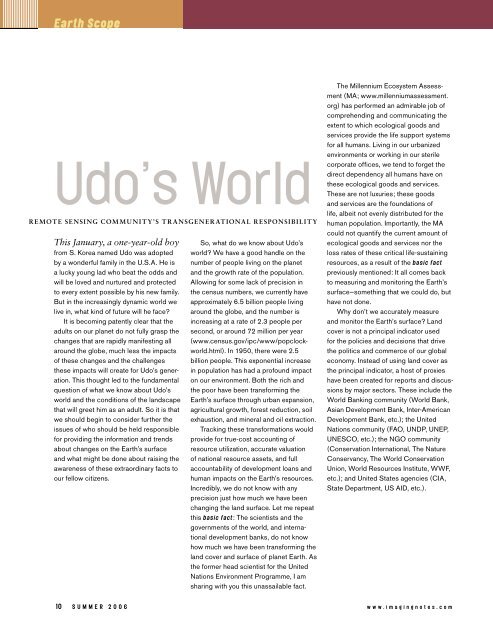download PDF - Imaging Notes
download PDF - Imaging Notes
download PDF - Imaging Notes
- No tags were found...
You also want an ePaper? Increase the reach of your titles
YUMPU automatically turns print PDFs into web optimized ePapers that Google loves.
Earth ScopeUdo’s WorldR emot e Sensi ng Com mu n ity’s Transgen er at iona l R esponsi bi lityThis January, a one-year-old boyfrom S. Korea named Udo was adoptedby a wonderful family in the U.S.A. He isa lucky young lad who beat the odds andwill be loved and nurtured and protectedto every extent possible by his new family.But in the increasingly dynamic world welive in, what kind of future will he face?It is becoming patently clear that theadults on our planet do not fully grasp thechanges that are rapidly manifesting allaround the globe, much less the impactsof these changes and the challengesthese impacts will create for Udo’s generation.This thought led to the fundamentalquestion of what we know about Udo’sworld and the conditions of the landscapethat will greet him as an adult. So it is thatwe should begin to consider further theissues of who should be held responsiblefor providing the information and trendsabout changes on the Earth’s surfaceand what might be done about raising theawareness of these extraordinary facts toour fellow citizens.So, what do we know about Udo’sworld? We have a good handle on thenumber of people living on the planetand the growth rate of the population.Allowing for some lack of precision inthe census numbers, we currently haveapproximately 6.5 billion people livingaround the globe, and the number isincreasing at a rate of 2.3 people persecond, or around 72 million per year(www.census.gov/ipc/www/popclockworld.html).In 1950, there were 2.5billion people. This exponential increasein population has had a profound impacton our environment. Both the rich andthe poor have been transforming theEarth’s surface through urban expansion,agricultural growth, forest reduction, soilexhaustion, and mineral and oil extraction.Tracking these transformations wouldprovide for true-cost accounting ofresource utilization, accurate valuationof national resource assets, and fullaccountability of development loans andhuman impacts on the Earth’s resources.Incredibly, we do not know with anyprecision just how much we have beenchanging the land surface. Let me repeatthis basic fact: The scientists and thegovernments of the world, and internationaldevelopment banks, do not knowhow much we have been transforming theland cover and surface of planet Earth. Asthe former head scientist for the UnitedNations Environment Programme, I amsharing with you this unassailable fact.The Millennium Ecosystem Assessment(MA; www.millenniumassessment.org) has performed an admirable job ofcomprehending and communicating theextent to which ecological goods andservices provide the life support systemsfor all humans. Living in our urbanizedenvironments or working in our sterilecorporate offices, we tend to forget thedirect dependency all humans have onthese ecological goods and services.These are not luxuries; these goodsand services are the foundations oflife, albeit not evenly distributed for thehuman population. Importantly, the MAcould not quantify the current amount ofecological goods and services nor theloss rates of these critical life-sustainingresources, as a result of the basic factpreviously mentioned: It all comes backto measuring and monitoring the Earth’ssurface—something that we could do, buthave not done.Why don’t we accurately measureand monitor the Earth’s surface? Landcover is not a principal indicator usedfor the policies and decisions that drivethe politics and commerce of our globaleconomy. Instead of using land cover asthe principal indicator, a host of proxieshave been created for reports and discussionsby major sectors. These include theWorld Banking community (World Bank,Asian Development Bank, Inter-AmericanDevelopment Bank, etc.); the UnitedNations community (FAO, UNDP, UNEP,UNESCO, etc.); the NGO community(Conservation International, The NatureConservancy, The World ConservationUnion, World Resources Institute, WWF,etc.); and United States agencies (CIA,State Department, US AID, etc.).10 s u m m e r 2 0 0 6 w w w . i m a g i n g n o t e s . c o m











